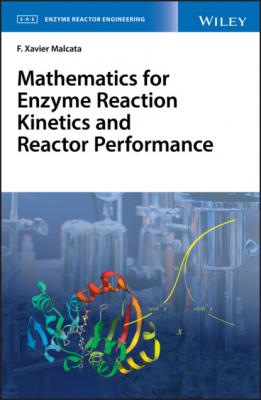Mathematics for Enzyme Reaction Kinetics and Reactor Performance. F. Xavier Malcata
Читать онлайн.| Название | Mathematics for Enzyme Reaction Kinetics and Reactor Performance |
|---|---|
| Автор произведения | F. Xavier Malcata |
| Жанр | Химия |
| Серия | |
| Издательство | Химия |
| Год выпуска | 0 |
| isbn | 9781119490333 |
– where (m × n) matrix A was partitioned through (m1 × n1) matrix A1,1, (m1 × n2) matrix A1,2, (m2 × n1) matrix A2,1, and (m2 × n2) matrix A2,2 as constitutive blocks, with m1 + m2 = m and n1 + n2 = n; coupled with
– with (p × q) matrix B partitioned as (p1 × q1) matrix B1,1, (p1 × q2) matrix B1,2, (p2 × q1) matrix B2,1, and (p2 × q2) matrix B2,2 as constitutive blocks – as well as p1 + p2 = p and q1 + q2 = q. The product AB is possible if n = p, besides the number of columns of the blocks of A coinciding with the number of rows of the corresponding blocks of B . In fact, the said product will look like
following the regular algorithm of multiplication of matrices – as long as n1 = p1 to allow existence of A1,1 B1,1, A1,1 B1,2, A2,1 B1,1, and A2,1 B1,2, as well as n2 = p2 to allow calculation of A1,2 B2,1, A1,2 B2,2, A2,2 B2,1, and A2,2 B2,2. This approach is particularly advantageous when one (or more) of the foregoing blocks is either an identity or a null matrix – since the matrix elements in Eq. (4.88) would yield much simpler expressions, involving only a portion of A or B rather than their whole set of elements. Such a concept may logically be extended to any partition as factor matrices – provided that it is mathematically feasible per se, and the associated block matrices are compatible with regard to multiplication.
Consider now (m × n) matrix A, (n × p) matrix B, and (p × m) matrix C; (m × p) matrix AB exists, and its product by (p × m) matrix C will eventually lead to (m × m) matrix ABC – so there will be a true main diagonal of ABC for it being square, and its trace can accordingly be calculated. Recall the associative property of multiplication of matrices, i.e.
(4.89)
as per Eq. (4.57); assuming matrices A and B are defined by their generic elements ai,j and bj,k, as per Eq. (4.1), and
en lieu of Eq. (4.46), respectively, one may multiply A by B to get
A similar reasoning may be applied to multiplication of matrix AB by matrix C, with generic element ck,l, viz.
ordered multiplication of Eqs. (4.91) and (4.92) leads indeed to
(4.93)
where the associative property of multiplication of scalars was taken on board. The trace will pick up the sum of only the elements in the main diagonal, i.e. those abiding to l = i, according to
where advantage was implicitly taken of the commutativity of addition of scalars; however, the order of factors in each term and corresponding summations is arbitrary – because both addition and multiplication of scalars are commutative, while the limits of the said summations are independent of each other. Consequently, Eq. (4.94) may be rewritten as
where the definition of trace of a matrix was recalled once more; on the other hand,
(4.96)
as per Eqs. (4.90)-(4.92) – following convenient relabeling of subscript (dummy)l toi, since C ≡ [ck,i] ≡ [ck,l] plays the role of generic element, with j holding no relationship to i (or l, for that matter). Hence, the product of BC by A looks like
(4.97)
where A ≡ [ai,j] ≡ [ai,l] for absence of constraints encompassing j and l; Eq. (4.2) was again followed, coupled with the distributive property of multiplication of scalars. The trace of ( BC) A abides to
based on its definition; the right‐hand side of Eq. (4.98) is identical to the right‐hand side of
